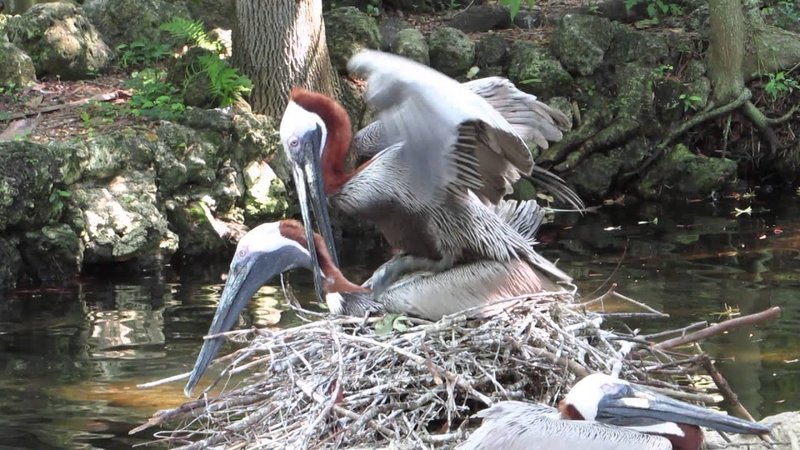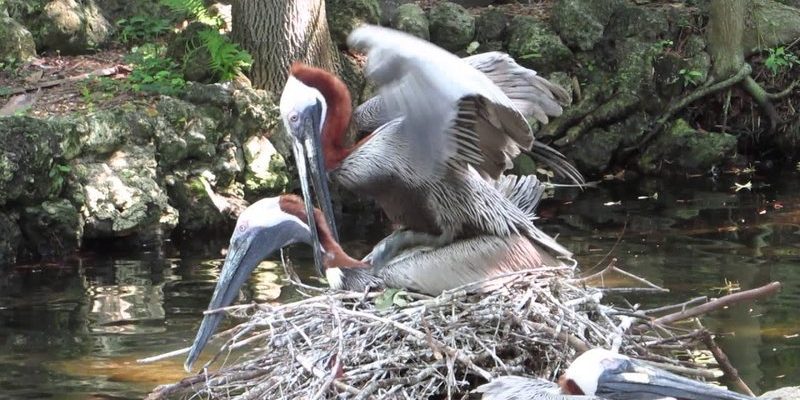
Pelican courtship is a blend of displays, sounds, and even synchronized movements that mirror the choreography of a ballet. These rituals not only help pelicans connect with potential partners but also ensure the survival of their species. In this article, we’ll dive deep into the world of pelican courtship and mating, exploring how these incredible birds attract and choose their mates.
The Courtship Dance: A Visual Spectacle
Let’s start with the visual aspect of peacock wooing. In the avian world, looks can be everything, and pelicans certainly know how to flaunt their features. During the courtship period, you might see a male pelican puffing out his throat pouch, which can be quite impressive. It’s not just for show; it’s a way to demonstrate his health and vigor to potential mates. In essence, it’s like the bird equivalent of strutting around in a flashy outfit.
After the puffing, the males often engage in synchronized movements with their partners. They’ll perform a gentle dance where they circle each other while bobbing their heads or flapping their wings. It’s mesmerizing to watch—like a slow, graceful waltz in the air. Imagine two dancers perfectly in sync, moving together effortlessly. This performance not only verifies their compatibility but also strengthens their bond.
While all this may seem trivial, the stunning visuals play a practical role too. Courtship displays can help pelicans establish territories and attract mates, which ultimately boosts their chances of successful reproduction. Here’s the thing: without these rituals, pelicans might struggle to find each other or properly defend their nests.
Vocalizations: The Language of Love
Just as a romantic relationship often blossoms through conversation, pelicans also communicate with one another through a series of unique sounds. The vocalizations they produce during courtship are integral to their mating rituals. Different species of pelicans have distinct calls, ranging from grunts to croaks, and even soft coos.
These sounds serve various purposes. For starters, the calls can signal to potential mates that a male is ready and available, much like a single person announcing their status at a party. But these vocalizations also play a critical role in maintaining coordination during their synchronized displays. Imagine trying to dance with someone without music—it’s tricky! So, these calls keep both partners in sync during their elaborate courtship displays.
Beyond attracting mates, vocalizations help pelicans establish a sense of territoriality. By calling out from their chosen nesting spots, they can communicate their presence and discourage other pelicans from encroaching on their breeding territory. This double function of courtship calls makes them essential to the entire mating process.
Building the Nest: A Joint Effort
Once a pair of pelicans has gone through the courtship phase, it’s time to settle down—figuratively speaking, of course. Nest building is a significant part of their mating rituals and often involves teamwork. Both the male and female contribute to gathering materials. They usually choose a spot near the water, where they can easily find food and protect their nest from predators.
Pelicans tend to use sticks, seaweed, and other available materials to build their nests. You might think of this as a symbolic representation of their partnership. Just like in a relationship, both parties need to put in the effort to create a safe and nurturing environment for their future offspring. It’s fascinating to observe how they work together, flying off to gather materials and then returning to build their home.
Creating the nest is also a way for pelicans to reinforce their bond. Working in harmony helps ensure they’re a compatible pair, ready to face the challenges of parenthood together. At this point in their courtship, trust and collaboration are crucial, laying the foundation for successful breeding.
Egg Laying: The Fruit of Their Labor
After the nest is built, it’s time for the big moment: laying eggs. Pelicans typically lay between two to four eggs, depending on the species and environmental conditions. The female usually selects the best position in the nest to ensure maximum protection for her eggs.
The eggs are generally a bluish or greenish color, which helps to camouflage them within the nest and reduces the chance of predation. You might say this is nature’s way of playing it safe—an instinctual method of keeping their future young ones hidden from potential threats.
Here’s where it gets interesting: during the incubation period, both parents take turns keeping the eggs warm and protected. This cooperation not only showcases their dedication but also strengthens their bond as partners. It’s a beautiful sight, watching pelicans share the responsibility of nurturing their young.
Raising the Chicks: From Hatchling to Independence
Once the eggs hatch, the work isn’t over for the pelican parents. In fact, this is where the real challenge begins. The chicks are born helpless, relying completely on their parents for food and protection. Pelican parents are incredibly attentive, using their long bills to fish for food, which they then regurgitate into the mouths of their chicks. It’s a bit messy, but it’s an essential part of their feeding process!
While raising their young, both parents play an active role in teaching their chicks essential survival skills. They’ll often take the fledglings on excursions to show them how to fish and navigate their environment. You might picture this as a kind of avian school, where the parents serve as both teachers and nurturers.
As the chicks grow and develop their skills, they’ll eventually become independent. This transition is bittersweet, as it marks the end of the parents’ direct involvement in their lives. However, it’s also a sign of success, demonstrating that the courtship and mating rituals worked effectively.
The Importance of Courtship Rituals in Conservation
Understanding pelican courtship rituals is crucial, especially when it comes to conserving their populations. These rituals serve a vital function in ensuring healthy reproduction rates and overall species survival. With many pelican species facing threats from habitat loss, pollution, and climate change, it’s essential to appreciate and protect the environments where these beautiful birds court, mate, and raise their young.
By shining a light on their fascinating courtship behaviors, we can foster a deeper connection with these remarkable creatures. Conservation efforts can be bolstered by educating the public about the importance of protecting habitats that support not only pelicans but the entire ecosystem around them.
In essence, when we take care of their homes, we also support the exquisite courtship and mating rituals that are essential for the continuation of pelican populations. This understanding drives home the message: every little bit counts when it comes to preserving our wildlife.
As we wrap up our exploration of the courtship and mating rituals of pelicans, we’ve seen just how intricate and vital these processes are—not just for the individual birds but for the overall ecosystem. By appreciating the beauty and complexity of their behaviors, we can advocate for their protection and ensure that generations to come get to witness these stunning displays. Pelicans are truly remarkable creatures, and their courtship rituals reflect the wonder of nature in our own backyard.

